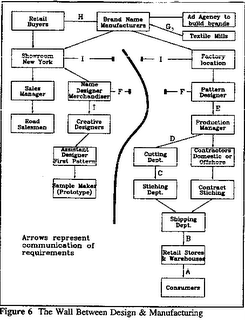

In 1957, when working as a designer for a moderate dress house in Boston, I was inspired by the famous Balenciaga's "chemise" dress, and designed my own unique version with a bow on the back, for me to wear. It is a great story I have told hundreds of times since - "How fads are created, die, and sometimes reincarnated with a new name or form."
Before 1957, the only mass market styles that had sold for a couple of decades were all based on the "shirt-maker dress", with a tightly belted waist. When Balenciaga, Paris, designed the chemise (a term from 1920s of a straight hanging dress) I fell in love with it, and designed a version for myself. My boss was intrigued, and suggested I design one for our line of moderate-priced dresses - $11.75 wholesale, $22 retail. The one in the photo is an exact replica I did for a recent fashion show.
We sent it to the New York showroom, where buyers laughed at it, so it was put on a rack to come back to Boston. A buyer from J. L. Hudson's in Detroit saw it, and exclaimed: "Is this a chemise? I'll buy it for an ad – if you cut it." We put it back on the line, and sold very few, about 200. We decided to cut it – just to order - that is, not cutting the many extras to prepare for reorders. When it hit the stores – it astounded us all – it sold out so fast, and reordered so many tmes that we were completely producing only chemise dresses for two years. SECONDS IN TIMING AND I WOULDN'T HAVE HAD THIS GREAT SUCCESS - THE 2nd HOTTEST CHEMISE DRESS IN THE MARKET.
THE FAD:
After two years, the chemise died. It took research and time to discover why. Every buyer said don't even mention the name chemise. "We're stuck with a whole bunch of them in inventory. Fortunately for us, our chemise dress sold out, but the "bad ones" were like bad apples and poisoned ours as well. Why were they bad? Most dress manufacturers saw the chemise as a "golden apple", took their shirtmaker dress patterns, let out the darts and let them "hang". They were horrible on the body. Ours was beautiful because I had "shaped" the chemise as a beautiful form, emulating Balenciaga's great sculpture in my unique styling. FADS DIE BECAUSE EVERYONE GETS IN ON THEM AND FLOODS THE MARKET WITH POOR VERSIONS.
REINCARNATION:
It was years later that I began noticing the chemise in stores again, but never called the chemise. It was now called the SHIFT. It sells to this day as the shift dress, and has become a commodity item for women's house dresses, and occasionally higher styling. Interestingly, as I monitor technology as well as fashion, I saw a similar event replicated in robots, and more recently in the "dot,coms". It all comes down to "quality". When everyone gets into a big selling item and makes it, and does it, poorly, the item dies, and it's called a fad. But, those that continue to do it right, or study how to do it right, reincarnate the item, but it always becomes quieter, without any market hype. That is happening with robotics, and the dot,coms, today. In my engineering design papers I explain this as my "Chemise Theory". It's a fun story, and I've told it at many seminars.
Please, readers, let me know some comments, even if it's just to tell me you read it. Then I'll keep the stories coming. I have many to tell. Thanks



